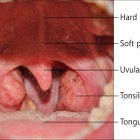What Are Tonsils?
The human immune system is one of Mother Nature’s masterpieces. It consists of masses of lymphoid tissue scattered through the body to identify and attack harmful invading germs, viruses and fungi. Many of us know that the neck, armpits and groin contain lymphoid tissue.
What many of us don’t realize is that our tonsils are made of lymphoid tissue. Having these infection fighters in the mouth and throat makes perfect sense, considering the potentially harmful substances we inhale or ingest every day.
Waldemeyer’s Ring
The tonsils form a system designed to prevent upper respiratory infections. Called Waldemeyer’s ring, this system encircles the upper respiratory tract. The palatine tonsils cover the throat’s sides. Their covering of pink mucosa resembles the mouth’s lining, except that it’s pitted with areas called crypts.
The adenoids, or pharyngeal tonsils, sit on the roof of the mouth at the back of the nasal cavity. In children the adenoids are visible as a soft mound where the nasal and oral cavities come together.
The pair of lingual tonsils rests on the back of the base of the tongue. Composed of dense lymphoid tissues, each of these tonsils has a single crypt, or pit, into which its mucous gland ducts drain. Connective tissue partially encloses the lingual tonsils.
Waldemeyer’s ring is most active in children between the ages of 3 and 6. As millions of parents know, that’s when children are most likely to have colds, sore throats and ear infections.
How Tonsils Work
With our every swallow or breath, the tonsils identify incoming substances as friendly or hostile. They trap the hostile ones and release antibodies to destroy them. These specialized proteins circulate in the bloodstream, targeting and eliminating specific organisms.
Researchers from the Oklahoma Medical Research Foundation’s Immunology Program have identified five antibody types produced in palatine tonsils. They battle staph, strep, polio, flu and diphtheria bacteria and viruses. Such a powerful defense system would seem immune to attacks on its own tissue.
Unfortunately, that’s not the case. The tonsils themselves are vulnerable to disorders requiring medical or surgical treatment.

Tonsillitis
The Mayo Clinic defines tonsillitis as a bacterial or viral inflammation of the tonsils. As they bar germs and viruses from entering the body, the tonsils themselves may become infected. Group A Streptococci bacteria often cause tonsillitis. The Epstein-Barr virus responsible for infectious mononucleosis can cause tonsillitis in older children. Viral tonsillitis persists up to three months, advises the BBC’s Dr. Trisha Macnair.
Tonsillitis symptoms include:
• Swollen, red tonsils with patches of yellow or white
• Difficulty swallowing
• A scratchy voice
• Fever
• A stiff neck with enlarged lymph nodes
• Headache
Abscess of the Tonsils
Peritonsillar abscess, a complication of untreated tonsillitis, surfaces as an accumulation of pus around the tonsils. A severe abscess may rupture, spreading infection from the tonsils to the palate and lungs. Symptoms include:
• Fever
• Sore throat
• Hoarse voice
• Drooling
• Facial swelling
• Throat and jaw tenderness
Possible complications from untreated abscessed tonsils include obstructed airways, fluid buildup in the lungs, cardiac infection and pneumonia.
Cancer of the Tonsils
Men between the ages of 50 and 70 with a history of smoking and alcohol consumption have the greatest risk of tonsillar cancer, according to the Merck Manual. A growth in the neck and throat soreness that spreads to the ears indicate the disease. Untreated tonsillar cancer can spread from the lymph nodes throughout the body.
Treating Disorders of the Tonsils,
A 10-day course of oral penicillin is the standard treatment for bacterial tonsillitis. Viral tonsillitis doesn’t respond to antibiotics. The Mayo Clinic advises a treatment regimen of salt-water gargling, regular consumption of warm liquids and non-prescription pain medicine like acetaminophen or ibuprofen.
Treatment for abscessed tonsils includes antibiotics, prescription pain medication and draining the abscesses. Surgical tumor removal, radiation and chemotherapy are all used against tonsillar cancer.
The National Institutes of Health recommend tonsillectomy for children with seven or more throat infections over one year, five or more infections over two years or tonsils with abscesses or growths. With the patient under general anesthesia, the doctor props open the mouth and burns or cuts away the tonsils. Many doctors advise simultaneous adenoid removal.
